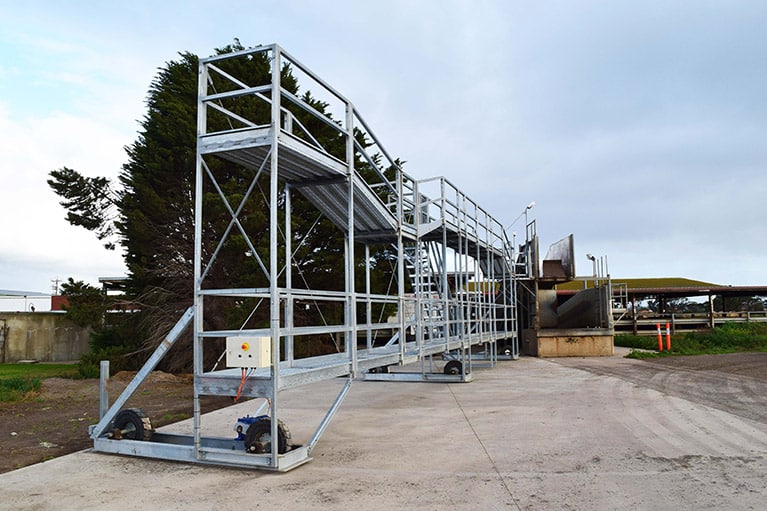Article courtesy: Prime Mover Magazine
The trial of a revolutionary parallel access landing (PAL) platform at Kilcoy Global Foods in Queensland is revealing remarkable improvements in safety and productivity for B-double stock crate operators unloading cattle at the facility.
It alleviates the age-old safety risks involved with drivers having to climb up the sides or on top of the crates to open gates and coax cattle to egress.
A joint initiative of the Australian Livestock and Rural Transporters Association (ALRTA) and Kilcoy Global Foods, the PAL project is funded by the National Heavy Vehicle Regulator (NHVR) with significant financial support from the Federal Government which has reportedly allocated $3.9 million in funding for Round 2 of the Heavy Vehicle Safety Initiative program.
Of this, $102,000 has been earmarked for ALRTA to help fund a feasibility study into user-pay unloading infrastructure at Kilcoy Global Foods.
At the recent official launch of the research trial were Federal Assistant Minister for Road Safety and Freight Transport, Scott Buchholz, NHVR CEO, Sal Petroccitto and Martins Stock Haulage at Oakey (QLD) General Manager, Trevor Heinrich, among others.
Livestock and Rural Transporters Association of Queensland member, Fiona Wild, addressed the gathering saying that loading and unloading livestock is the most dangerous part of the transport task.
“However, well designed infrastructure can reduce safety risks while improving productivity,” said Wild.
“At this site, ProWay Livestock Equipment has built and installed an innovative PAL that moves alongside livestock trailers to allow drivers to access all levels safely and quickly.”


Wild said drivers will no longer need to be climbing on the tops or sides of the trailers, reducing the potential for trips, slips, bruising, crushing, cuts and falling from heights.
“The PAL frame is available for use on a voluntary basis and a user charge will be levied, starting at $15 and reducing by $2.50 each fortnight until it is removed completely,” said Wild.
“ALRTA will monitor the usage rates and different charging levels to determine the willingness to pay and optimal payback periods.
She affirmed that in the first three weeks of operation it has been clear that transport operators are willing to make a contribution towards safer unloading infrastructure.
“We hope this trial will demonstrate that rapid infrastructure upgrades are possible when supply chain parties work together, share costs and realise the benefits.”
Scott Buchholz said that the Federal Government is committed to investing no less than $100 billion over the next decade into infrastructure and road safety.
“It is this safety initiative that we are witnessing here today and others that we are helping to fund which hopefully will curb serious accidents and fatalities within the transport industry,” said Buchholz.
“This PAL is an initiative we need to embrace,” he said. “If it creates an environment where we prevent one fatality or serious injury then it has been a great investment.”


As General Manager of Martins, one of the larger stock hauling outfits in the country, Trevor Heinrich said a number of abattoirs in Queensland are using different types of access landing platforms to improve safety outcomes and the results have been extremely positive.
“The industry is starting to get onboard with these safety systems, which is a great thing,” said Heinrich.
“The processes of loading and unloading with drivers needing to climb up and down the crates in addition to dealing with live animals have traditionally been our biggest risk factors.”
Prime Mover Magazine witnessed an impressive demonstration of the PAL with the unloading of several B-double loads of cattle at the Kilcoy facility.
After the truck is backed up to the ramp the driver presses a button which activates the wheel motors and within 35 seconds the PAL is in position adjacent to the crate. With personnel working on both levels to open and shut gates at the rear and between the crates, the cattle file off from both decks simultaneously within 3.5 minutes. Another 35 seconds to return the PAL to its parking spot and the driver pulls away from the ramp less than five minutes after docking.
The whole exercise is completed like clockwork with the PAL providing a supremely safe and efficient working platform during the entire unloading process.

